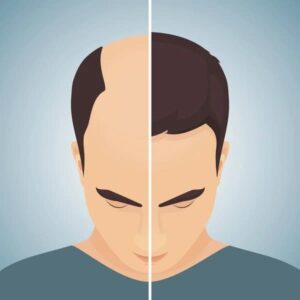What To Do If You’re Suffering With Hair Loss After Your Surgery
In most cases, hair transplant aftercare and recovery should be a seamless process. However, hair transplant surgery can produce some side effects in rare cases. So, it’s vital you know what to look for in case you think you’re suffering from side effects after your hair transplant. On this page, you’ll find everything you need to know about hair transplantation side effects, how to spot them, and what you can do to keep your new grafts in tip-top shape!
Key Takeaways
- Hair transplantation is a safe and risk-free medical procedure. One study showed minor post-surgery complications to occur in 0.1% of cases (Garg et. al, 2021). Follicular unit extraction (FUE) and Direct Hair Implantation (DHI) produce the fewest side effects.
- The most common side effect after a hair transplant is sterile folliculitis. This is a minor infection that causes swelling and itchiness. If left untreated, it can affect the result of your hair transplant surgery.
- Most side effects are easily treatable if caught early. You should keep in contact with your hair transplant surgeon if you think you may be suffering from side effects after your hair transplant.
What are Hair Transplant Side Effects?
Hair transplant side effects are an uncommon occurrence that is sometimes exhibited while a patient is recovering. While the hair transplant recovery process takes around a year to complete (for the head to heal and implanted hair to grow), side effects are most commonly seen 0-1 month after a procedure.
If you encounter a side effect during your hair transplant aftercare, it may feel quite concerning. However, most side effects will resolve themselves naturally. Other side effects are easily treatable and will not affect the growth of your new hair follicles if treated early.
If you think you may be experiencing a side effect, no matter how great or small, the most important thing to do is contact your hair transplant surgeon or clinic. They will usually ask for photographic evidence of the side effects you’re experiencing. From here, you will be given further guidance, whether that be booking in for a consultation, receiving prescription antibiotics, or being told that everything is actually in order! The crucial thing is not to panic and keep your clinic up to date with your recovery process.
Side effects are often noticeable by the effects they have on the body. In hair transplantation, common symptoms of side effects include but are not limited to:
- redness on the scalp
- itchiness on the scalp
- dry skin on the scalp or back of the head
- numbness on the scalp
How Frequently Do Hair Transplant Side Effects Occur?
The truth is, it’s hard to say how frequently hair transplant side effects occur. Evidence correlating the number of side effects relating to hair transplant surgery is still in its infancy and more studies need to be conducted to gain a greater insight into the prevalence of side effects during the recovery process.
One study has shown the most common side effect of hair transplant surgery is sterile folliculitis. In a group of 2896 participants who agreed to share their aftercare journey, 208 patients experienced folliculitis at some point in their aftercare process. That’s just over 7% of patients.
However, results from this study are unconvincing given that the sample size takes into account numerous surgical methods – Follicular Unit Transplantation (FUT), Follicular Unit Extraction (FUE), Direct Hair Implantation (DHI) – as well as numerous types of hair transplant (hair transplants, beard transplants, and eyebrow transplants).
It’s also important to note that this study was conducted by the Indian Journal of Plastic Surgery and followed patients who opted for their surgery in India, rather than the UK, US, or Turkey. This means it is difficult to know what the rate of these side effects would be in other countries and whether the results of this study apply to the rest of the world.
If you’re worried about hair transplant side effects, the best thing to do is make an informed decision about what clinic is going to be right for you. To minimise the risk of side effects, it’s important to opt with a company that performs their procedures in a CQC-registered clinic and your surgery is doctor-performed (ideally with a surgeon who has GMC and ISHRS accreditation).
If you’re interested in having a hair transplant surgery but want to talk in more detail about the potential risks and side effects, book a free video consultation with one of our specially trained consultants. We’re always happy to help!
What Are Common Side Effects After a Hair Transplant Surgery?
After a hair transplant, it’s common to experience some side effects, though they typically subside within a few days to a few weeks. We have devised this list of side effects and symptoms so you can work out what you may be experiencing during your aftercare process.
Pain or Discomfort on the Scalp (0-1 Weeks)
Mild pain or discomfort around the transplant area is common in the first few days after surgery. As the local anaesthetic wears off, many patients tend to experience soreness, bruising, or general discomfort after their hair transplant.
Although hair transplants are minimally invasive, the surgery on the day can cause inflammation around the donor area and recipient site. It is this inflammation that causes pain or discomfort on the scalp. This can usually be managed by taking over-the-counter pain relievers such as Ibuprofen or Paracetamol.
Itchiness on the Scalp (0-1 Weeks)
Another common side effect experienced immediately after hair transplantation surgery may be itchiness or dryness on the scalp. This is very common in the first 7 days as the hair follicles begin to regenerate.
It’s important not to scratch the scalp to avoid disrupting the grafts that have just been transplanted. To combat this, all patients are provided with a small saline solution spray that can be sprayed onto the itchy area instead of scratching.
If your itchiness or a dry scalp persists for many weeks after your hair transplant, then this may be a sign of an infection like folliculitis. To treat this condition, antibiotics are required, so it is important to consult your surgeon/clinic if this persists. Leaving folliculitis
Scabbing or Crusting After Hair Transplantation (0-1 Weeks)
After your hair transplant, you will see small scabs or crusts form around the transplanted hair and donor site as they heal. Scabbing and crusting is a good sign as it demonstrates your body can form clots, protecting the small wounds from infections.
It’s important not to pick at these scabs for two reasons. First, to avoid damaging the newly transplanted follicles. Second, as stated above, it may also increase your risk of developing an infection.
Swelling After a Hair Transplant (0-2 Weeks)
Swelling of the scalp, forehead, or around the eyes can occur, particularly in the first few days following the procedure. During hair transplantation, local anaesthetic is injected around the scalp to numb the area for surgery.
In most patients, anaesthetic will break down naturally in the body and not cause noticeable swelling. In a small number of cases, visible swelling around the scalp or eyes may be visible. This is nothing to worry about and will eventually resolve itself.
Temporary swelling will only occur in the first couple of days after surgery. So, it will be resolved well before the end of your 14-day initial recovery period. It should not hinder you from getting back to work, the gym, or your typical daily routine.
Redness on the Scalp After Hair Transplantation (0-2 Weeks)
Following hair transplantation, the scalp may begin to look reddish or pinkish. This is completely normal and occurs due to increased blood flow around the scalp. For your scars to heal and to minimise chances of infection, plenty of blood (filled with platelets and white blood cells) is needed.
This is a normal part of the healing process and typically resolves within a week or two. No action needs to be taken to reduce redness or pinkness. It is not typically a sign (on its own) of infection.
Numbness on the Scalp (0-2 Weeks)
Temporary numbness or tingling in the scalp is an uncommon side effect that can occur after a hair transplant. This can be caused by many factors, including the slow breakdown of local anaesthesia, minor nerve damage incurred during the procedure, swelling, or oedema (minor fluid build-up).
This usually resolves on its own over time. If your symptoms of numbness persist, then it is important to contact the surgeon who performed your hair transplant.
Keloid Formation (2-6 Weeks)
Keloid formation after a hair transplant refers to the abnormal growth of scar tissue beyond the boundaries of the original wound. Keloids are raised, thickened, and often larger than the original injury site. They can be red or pink in colour and may feel tender or itchy.
In the context of a hair transplant, keloid formation is a potential side effect that can occur at the donor or recipient sites where incisions are made during the procedure. However, keloids are relatively rare in hair transplant surgery compared to other types of surgical procedures.
If you think you may be experiencing keloid formation after your hair transplant, it’s important to contact your hair transplant surgeon/clinic.
Shock loss After Hair Transplantation (4-6 Weeks)
“Shock loss” is a natural part of the recovery process and will affect all of your transplanted hair around 4-6 weeks after your hair transplant. Around this point, a patient will experience extensive hair loss on their recipient site and your hairline will temporarily look as it did before hair transplantation.
This is completely normal and needs to occur as your new hair follicles prepare for new growth. This shock hair loss is only temporary and once it has taken place, your hair follicles will begin to regrow again at a natural rate.
Infection (0-6 Months)
Although rare, infection is a potential risk following any surgical procedure. Although a hair transplant is a minimally invasive procedure, infections can occur. This is because dryness on the scalp and inconsistent scabbing can increase the risk of developing infections such as folliculitis.
Signs of infection include increased pain, swelling, redness, or drainage from the transplant site. If you suspect an infection, it’s important to contact your healthcare provider promptly.
Infections after a hair transplant are usually minor and are easily treatable with oral antibiotics. When taking antibiotics, you should see an improvement within 1-2 days and the infection should be fully treated after 7 days.
Conclusion
Hair transplant side effects can occur in rare instances after surgery. Although rare, you are most likely to experience hair transplant side effects in the immediate couple of weeks after your surgery. Most side effects will heal themselves, although more serious conditions are easily treatable with mild antibiotics.
If you think you may be suffering from a hair transplant side effect, or are feeling pain or discomfort after your surgery, the first thing to do is contact your hair transplant surgeon/clinic. They can help guide you on your aftercare journey and answer any questions or queries you may have.







